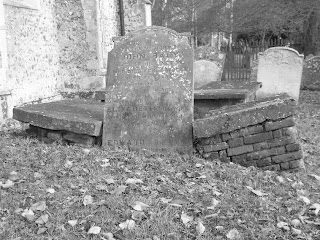 |
The Porch South Pickenham
© Godric Godricson
|
South Pickenham is a wonderful parish church built of flint and rubble and it is part of a fine Norfolk village. The village itself has reduced in size over the past thousand years and is little more than a collection of cottages and the 'big house' built in the Edwardian period. The church itself sits on a cross road as the small country road starts to rise away from the village centre. The round Tower marking the Church out as a site of special historical interest. I haven't been to a service taken at South Pickenham but I can't imagine many people go to the services in the church. It is just too far away from Swaffham or other local towns to attract people.
The moderately sized churchyard is entered through an inconspicuous country gate which leads from the road to the 18th-century porch and on into the Church proper. With particular interest to graveyard monuments it is interesting how the levels of the cemetery have risen to the point where the path is probably at least 12 inches below the general level of the modern surface in some places. Even with smaller contemporary populations of people living in the village we can see that continuous burials over a thousand years can lead to the surface level changing overtime. The grass that covers the cemetery is fairly rough and quite clearly does not receive a lot of attention. This is a churchyard that is rural and traditional in nature and bears none of the hallmarks of a manicured exterior. There is a seat on the south side of the Church and it is marvellous to sit there on a bright and sunny day to reflect on the nature of the building and of the place. It is good to pray for the dead and to wonder what it was like to live in South Pickenham.
 |
Some of the Putti surviving
at South Pickenham
© Godric Godricson
|
The memorials in the cemetery are varied and cover at least a 200 year period. We find the usual sandstone stele with putti in full flight looking down on the occupant and this seems to be the starting point of this cemetery in terms of memorials. Everything that went before has either been removed or has returned to the land with nothing of note from an earlier period. Wooden monuments, if they were evident, are no longer present and there is no noble family living in the village to make its mark in terms of memorials. So, sandstone monuments are the beginning for South Pickenham in terms of memorials. Before that time it is as if the people themselves did not exist and their passing has been forgotten.
 |
Concrete utilitarianism
© Godric Godricson
|
Subsequent to the sandstone memorials, so popular in Norfolk, we find a few Victorian monuments before they themselves yield to the hard concrete crosses that became popular in the early part of the 20th century. Often without ornament or adornment in any way; the hard concrete is stark and impervious in both nature and conceptualisation.
Utilitarian design and function surged forecfully into this cemetery and swept away all the joy found in earlier sandstone and in the process destroyed evidence of a belief in the Providential God. Strangely enough here at South Pickenham we do find two large memorials from the early 20th century that are imposing and speak of an almost Stalinist determination for immortality.












